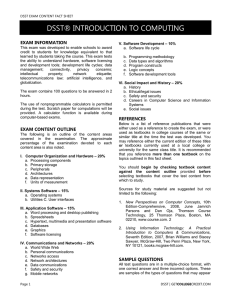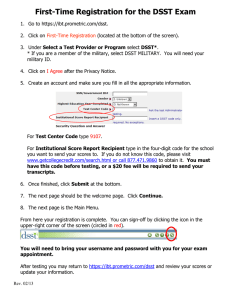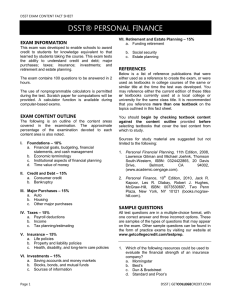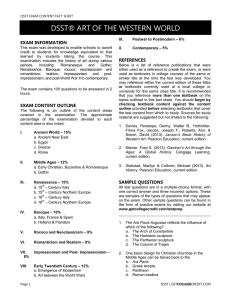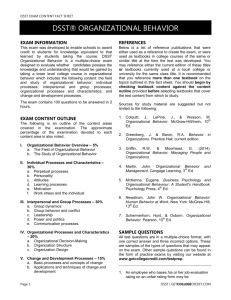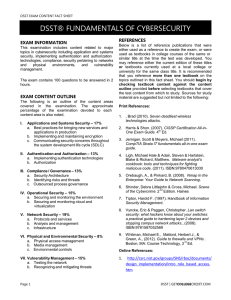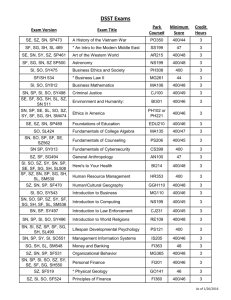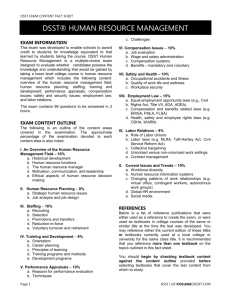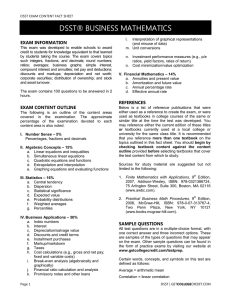DSST® PRINCIPLES OF FINANCIAL ACCOUNTING
advertisement
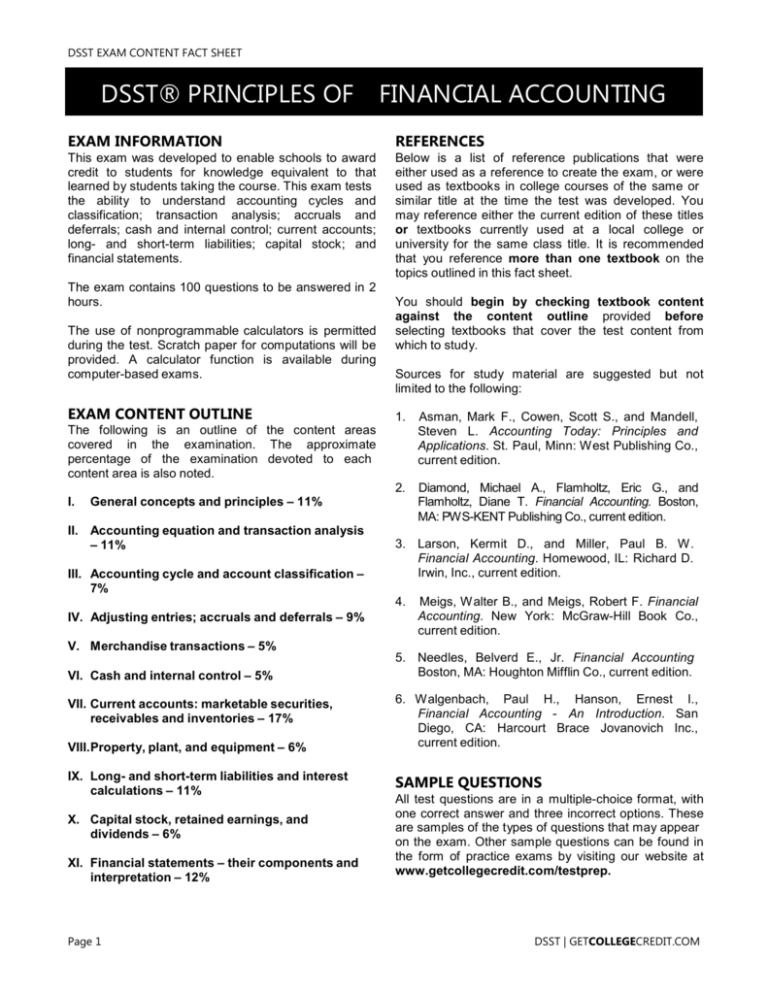
DSST EXAM CONTENT FACT SHEET DSST® PRINCIPLES OF FINANCIAL ACCOUNTING EXAM INFORMATION REFERENCES This exam was developed to enable schools to award credit to students for knowledge equivalent to that learned by students taking the course. This exam tests the ability to understand accounting cycles and classification; transaction analysis; accruals and deferrals; cash and internal control; current accounts; long- and short-term liabilities; capital stock; and financial statements. Below is a list of reference publications that were either used as a reference to create the exam, or were used as textbooks in college courses of the same or similar title at the time the test was developed. You may reference either the current edition of these titles or textbooks currently used at a local college or university for the same class title. It is recommended that you reference more than one textbook on the topics outlined in this fact sheet. The exam contains 100 questions to be answered in 2 hours. The use of nonprogrammable calculators is permitted during the test. Scratch paper for computations will be provided. A calculator function is available during computer-based exams. EXAM CONTENT OUTLINE You should begin by checking textbook content against the content outline provided before selecting textbooks that cover the test content from which to study. Sources for study material are suggested but not limited to the following: 1. Asman, Mark F., Cowen, Scott S., and Mandell, Steven L. Accounting Today: Principles and Applications. St. Paul, Minn: West Publishing Co., current edition. 2. Diamond, Michael A., Flamholtz, Eric G., and Flamholtz, Diane T. Financial Accounting. Boston, MA: PWS-KENT Publishing Co., current edition. The following is an outline of the content areas covered in the examination. The approximate percentage of the examination devoted to each content area is also noted. I. General concepts and principles – 11% II. Accounting equation and transaction analysis – 11% III. Accounting cycle and account classification – 7% 3. Larson, Kermit D., and Miller, Paul B. W. Financial Accounting. Homewood, IL: Richard D. Irwin, Inc., current edition. 4. IV. Adjusting entries; accruals and deferrals – 9% V. Merchandise transactions – 5% VI. Cash and internal control – 5% VII. Current accounts: marketable securities, receivables and inventories – 17% VIII.Property, plant, and equipment – 6% IX. Long- and short-term liabilities and interest calculations – 11% X. Capital stock, retained earnings, and dividends – 6% XI. Financial statements – their components and interpretation – 12% Page 1 Meigs, W alter B., and Meigs, Robert F. Financial Accounting. New York: McGraw-Hill Book Co., current edition. 5. Needles, Belverd E., Jr. Financial Accounting Boston, MA: Houghton Mifflin Co., current edition. 6. Walgenbach, Paul H., Hanson, Ernest I., Financial Accounting - An Introduction. San Diego, CA: Harcourt Brace Jovanovich Inc., current edition. SAMPLE QUESTIONS All test questions are in a multiple-choice format, with one correct answer and three incorrect options. These are samples of the types of questions that may appear on the exam. Other sample questions can be found in the form of practice exams by visiting our website at www.getcollegecredit.com/testprep. DSST | GETCOLLEGECREDIT.COM DSST EXAM CONTENT FACT SHEET – PRINCIPLES OF FINANCIAL ACCOUNTING Questions on the test require test takers to demonstrate the following abilities. Some questions require more than one of the abilities. • • • Knowledge of basic facts and terms (about 2535% of the examination) Understanding of concepts and principles (about 25-35% of the examination) Ability to apply knowledge to specific problems and situations (about 35-45% of the examination) 1. All of the following are considered asset accounts EXCEPT a. short-term investments b. capital stock c. cash d. land 2. On January 2, XYZ Company pays salaries previously accrued as of December 31. As a result of this transaction, the effect on the accounting equation is a. an increase in assets, an increase in liabilities b. a decrease in assets, a decrease in owners’ equity c. a decrease in assets, a decrease in liabilities d. a decrease in assets, an increase in liabilities 3. XYZ Company, which uses the periodic inventory method, has the following record for a particular inventory item. Jan 1 Feb 15 June 7 Oct 29 Beginning Balance Purchase Purchase Purchase 100 units @ $3.00 400 units @ $3.10 500 units @ $3.20 400 units @ $3.30 If 200 units remain in the inventory at December 31, what is their LIFO cost? a. $610 b. $630 c. $650 d. $660 4. A bank reconciliation is performed in order to a. verify the accuracy of a company's recorded cash balance b. ensure that all bank loans have been properly accounted for c. verify that all cash disbursements are for a legitimate business purpose d. verify that only authorized personnel signed the disbursement checks Page 2 5. RAM Company keeps its records on a calendar year basis and makes adjusting entries only at the close of each year. The unadjusted trial balance for December 31, Year 1, shows Unearned Revenue of $1,200 for a year's rent collected on October 1, Year 1. The rent is a oneyear lease ending September 30, Year 2. The adjusting entry needed on December 31, Year 2, should include a debit to a. unearned revenue for $300 b. unearned revenue for $900 c. rental revenue for $300 d. rental revenue for $1,200 6. A company receives a $5,000, 60-day, 8 percent note dated May 1, Year 1. What is the total amount of cash to be collected on the due date? (Assume a 360-day year.) a. $5,006.67 b. $5,050.00 c. $5,066.67 d. $5,666.67 7. Which of the following best describes the calculation of the gross profit rate? a. Net income is divided by net sales b. Net sales are divided by net assets c. The cost of goods sold is added to operating expenses, and the sum is divided by net sales d. The cost of goods sold is subtracted from net sales, and the difference is divided by net sales 8. Bonds with a face value of $100,000 are sold at 97½. This transaction will result in recording a. a discount of $975.00 b. a premium of $1,097.50 c. a discount of $2,500.00 d. an accrued interest of $9,750.00 9. On the date that a company declares a cash dividend, which of the following is true? a. Checks are mailed to the stockholders b. The company incurs a liability c. The stockholders’ equity is increased d. The assets of the firm are decreased 10. Which of the following would be of LEAST value in predicting a company's future net income? a. Extraordinary items of income b. Comparative income statements c. Net income from continuing operations d. An analysis of future changes in tax rates DSST | GETCOLLEGECREDIT.COM DSST EXAM CONTENT FACT SHEET – PRINCIPLES OF FINANCIAL ACCOUNTING CREDIT RECOMMENDATIONS The American Council on Education’s College Credit Recommendation Service (ACE CREDIT) has evaluated the DSST test development process and content of this exam. It has made the following recommendations: Area or Course Equivalent Principles of Financial Accounting Level Lower-level baccalaureate Amount of Credit Minimum Score Three (3) semester hours Source American Council on Education – College Credit Recommendation Service 400 ACE evaluations and credit recommendations have expired for this exam. As of December 31, 2014 DSST testing centers will no longer offer this exam. Answers to sample questions: 1-B, 2-C, 3-A, 4-A, 5-B, 6C, 7-D, 8-C, 9-B, 10-A. Rev 3/14 Page 3 DSST | GETCOLLEGECREDIT.COM
